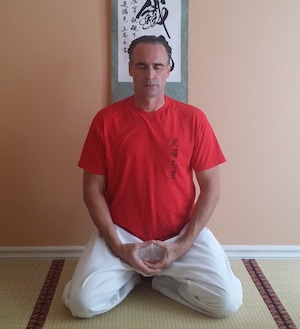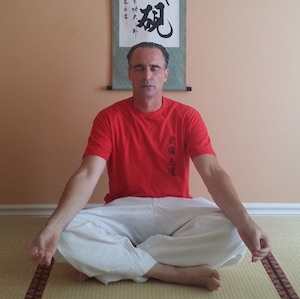The lotus posture is the main sitting position known by many students both in and outside of Yoga or the martial arts and can take the form of a full-lotus or half-lotus. The positions are used before and after classes to provide a moment of continuous seated meditation known as Joza-sammai. The Lotus positions are mirrored in the martial arts by Seiza (formal sitting position) and Anza (relaxed sitting position). Seiza is also referred to in the Zen arts as Zazen, literally meaning “seated meditation”.
The important elements to remember is not to curl your back forward and to keep your back straight with shoulders up. Your body should not feel tense and should be relaxed yet holding good posture. The arms are extended with the forearms balanced on the knees with the thumb and second finger touching lightly. Again, your arms should not be tight.
The eyes may be opened, closed or mid-way (Ying – Yang) during meditation. It is often said that for martial artists the eyes are never closed as a martial artist must be ready for an attack at any time. Typically, when the eyes are open or in half open position the gaze is focused approximately 6 feet (2 meters) ahead and on the mat.
The breath should not be labored. Breath deeply but comfortably. Deeper breaths may be taken when you further quiet yourself. Many schools of meditation used a counting system for the breathing. The count of 1 – 2 for the inhalation and then the count of 3 – 4 for the exhalation, continuing in this manner.
Meditation also does not solely have to happen from the Lotus, Seiza or Anza positions. And meditation can easily be achieved sitting in a regular chair. Meditation is more a state or mind than a posture. The important ingredient is to be aware of the meditation and to concentrate. Also, meditation should not be painful. Many students use a cushion in order to allow for a long period of time.
As mentioned elsewhere on this site Kata is considered moving meditation “neither sitting nor continuous moving”. And there are famous examples of non-martial artists who use moving meditation either circumambulating a practice hall or around a mountainside, both the practice hall and the mountain being considered a sacred object. The Marathon Monks of Mount Hiei are an example of monks who uniformly use moving meditation, Jogyo-sammai, as their practice.
The novice should try to meditate for periods of 5 minutes at a time. Again, meditation can be focused on the breathing, on a candle, simply gazing out towards the mat, on a sound using a bell or chime or on the contradictory meanings found within a zen riddle “koan”. Feel free to experiment with your own meditation practice and see what works for you. When you find what works for you then you may explore a deeper understanding.




